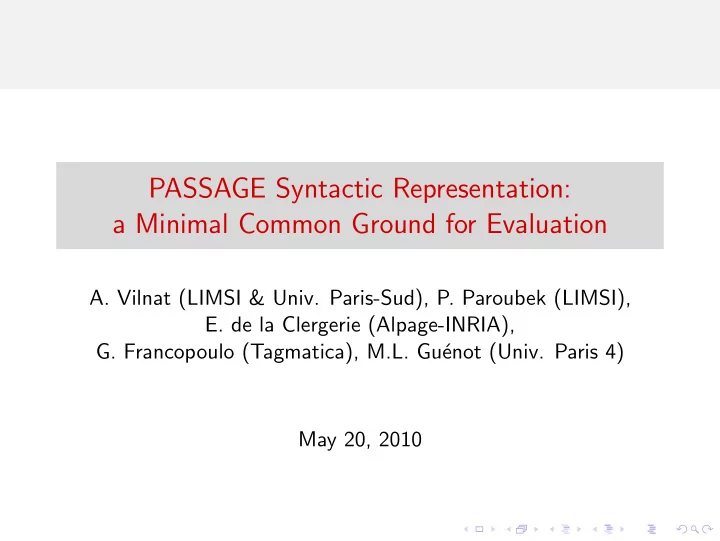

PASSAGE Syntactic Representation: a Minimal Common Ground for Evaluation A. Vilnat (LIMSI & Univ. Paris-Sud), P. Paroubek (LIMSI), E. de la Clergerie (Alpage-INRIA), G. Francopoulo (Tagmatica), M.L. Gu´ enot (Univ. Paris 4) May 20, 2010
Outline 1 General presentation 2 Linguistic phenomena Syntax vs. Semantics Subject relation Coordination 3 Standard XML format 4 Conclusion and Perspective
Context : PASSAGE project What is PASSAGE PASSAGE (ANR-06-MDCA-013): Produire des annotations syntaxiques ` a grande ´ echelle (Large Scale Production of Syntactic Annotations) Main tasks annotating a French corpus of about 100 million words using 10 parsers; manually building an annotated reference (400,000 words); merging the resulting annotations in order to improve annotation quality; performing knowledge acquisition from combined annotations; running two parsing evaluation campaigns.
Context : PASSAGE syntactic annotation 6 kinds of syntactic groups (small, generally not embedded,...), 14 syntactic relations linking groups and/or word forms.
Context: How to compare this annotated corpus? Why this annotation? to allow different parsing approaches (from shallow to deep) to retrieve a syntactic dependency structure with a possible matching from the results obtained by (at least) 10 parsers... Questions is it sufficient to deal with most linguistic phenomena? does it constitute a sufficient ground to go further (semantics) ? is it possible to compare/link it with other annotation formalisms ?
Syntactic head vs. Semantic head Some examples esident] GN 1 [des ´ [le pr´ Etats-Unis] GP 2 president of the United States [en guise] GP 1 [de r´ ecompense] GP 2 by way of reward [cet imb´ ecile] GN 1 [de Pierre] GP 2 this fool Pierre → same syntactic head: MOD-N(GP2,GN1) → different semantic heads: pr´ esident, r´ ecompense, Pierre
Syntax vs. Semantics: Valency vs. Transitivity Some examples [Je mange] NV 1 [de la soupe] GN 2 I am eating soup Relations : SUJ-V(Je, mange), COD-V(GN2, NV1) Valency (argument structure) : manger (je, soupe) → Identical structures [Il mange] NV 1 mais [ne grossit] NV 2 [pas] GR 3 He eats (a lot) but does not become fat Relations : SUJ-V(Il, mange), no COD-V Valency (argument structure) : manger (il, ∅ ) → PASSAGE does not annotate the lack of a relation which is semantically expected but syntactically not realised.
Syntax vs. Semantics: Valency vs. Transitivity Example 1 [Le vent] GN 1 [souffle] NV 2 The wind is blowing Relations : SUJ-V(GN1, NV2) Valency (argument structure) : souffler (vent) → Identical structures : the subject is the first semantic argument Example 2 [Il souffle] NV 1 [un vent] GN 2 [` a d´ ecorner] PV 3 [les bœufs] GN 4 It is blowing a gale Relations : SUJ-V(Il, souffle), COD-V(GN2, NV1),... Valency (argument structure) : souffler (un vent) → the COD-V is the first argument
Subject relation : Control Infinitive [Pierre] GN 1 [propose] NV 2 [` a Paul] GP 3 [de venir] PV 4 Pierre proposes Paul to come Relations : SUJ-V(GN1, NV2), SUJ-V(GP3, PV4) [Avant de partir] PV 1 [Marie] GN 2 [´ eteint] NV 3 [la lumi` ere] GN 4 Before leaving, Marie swithches off the light Relations : SUJ-V(GN2, NV3), SUJ-V(GN2, PV1) [Fumer] NV 1 [tue] NV 2 Smoke kills Relations : SUJ-V(NV1, NV2) → The verb fumer has no subject
Subject relation: compound tenses For a long time, I have lived as they do, and I suffered the same illness → SUJ-V : agreement constraint → SUJ-V + AUX-V gives the subject of the main verb.
Subject relation : Passive Infinitive [Pierre] GN 1 [est] NV 2 [applaudi] NV 3 Pierre is applaused Relations : SUJ-V(GN1, NV2), AUX-V(NV2, NV3) → The verb applaudi has no deep subject. [Le livre] GN 1 [est] NV 2 [applaudi] NV 3 [par la critique] GP 4 The book is applaused by critics Relations : SUJ-V(GN1, NV2), AUX-V(NV2, NV3), CPL-V(GP4, NV3) → The verb applaudi has a deep subject annotated as CPL-V.
Coordination: 3 annotations SD and GR annotations come from (Marneffe & Manning 08)
Standard XML format Specifications and requirements ISO TC37 specifications for morpho-syntactic and syntactic annotation: MAF (ISO 24611) http://lirics.loria.fr/doc_pub/maf.pdf SynAF (ISO 24615) http://lirics.loria.fr/doc_pub/N421_SynAF_CD_ISO_24615.pdf The format used during the previous EASY campaign in order to minimize porting effort The degree of legibility of the XML tagging.
Standard XML format Figure: UML diagram of the structure of an annotated document
Standard XML format < T id=”t0” start=”0” end=”3” > Les < /T > < W id=”w0” tokens=”t0” pos=”definiteArticle” lemma=”le” form=”les” mstag=”nP”/ > < T id=”t1” start=”4” end=”11” > chaises < /T > < W id=”w1” tokens=”t1” pos=”commonNoun” lemma=”chaise” form=”chaises” mstag=”nP gF”/ >
Conclusion and perspective Open questions is it sufficient to deal with some well known linguistic phenomena? → for our main goal (syntactic features): an experimental proof ... does it constitute a sufficient ground to go further (semantics)? → we hope so! At least, we have the necessary information to do it is it possible to compare/link it with other annotation formalisms? → Just at the beginning... new question: how to address other languages? → to be studied for specific syntactic features
Conclusion and perspective Perspective to compare our annotation scheme with what is done in Italy, in EVALITA, with TUT and CoNLL formalisms an Italian text and a French one (European texts) annotated following the different annotation schemes, with possible projection frm each shema onto the other. and with other languages...
Recommend
More recommend